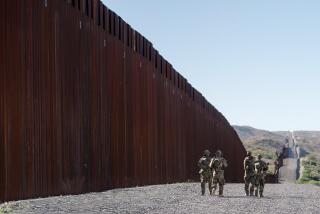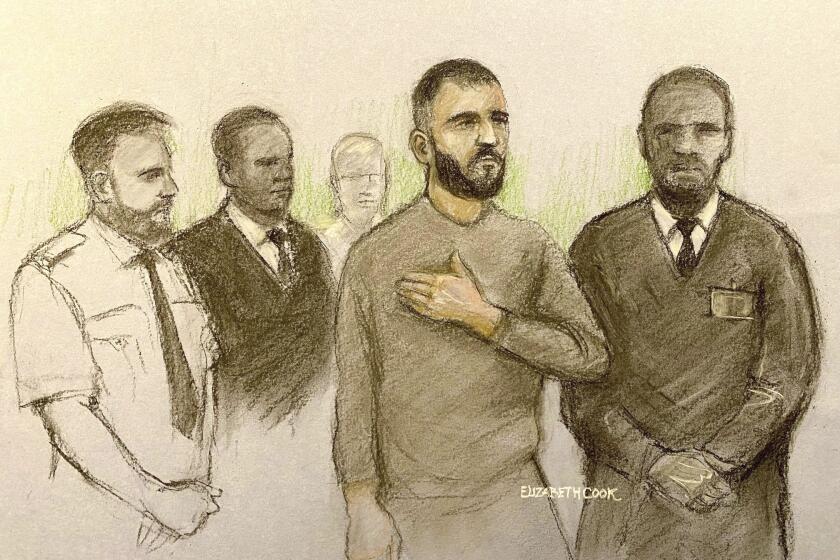World According to Waco: Conspiracy Theorists...
Welcome. World’s Most Persecuted Church.
--Sign at Branch Davidian property near Waco
For the last year and a half, Amo Bishop Roden has seen the visitors arrive. They pull up in their cars, their trucks, their vans. They get out, wander around. They try to absorb the spirit of the spooky, ravaged and oddly beautiful place she calls home.
Sometimes, they take jokey pictures of each other amid the ruins. Sometimes, they ask lots of questions. Sometimes, they cry.
“A lot of women cry here,” Roden said in a soft voice almost lost to the wind whooshing through a chinaberry tree. “I suppose that’ll be the same in Oklahoma when they put a monument there.”
It was on April 19, during the dedication of a monument to the perished members of the Branch Davidian religious sect here, that Roden first learned of the bombing of a federal building in Oklahoma City.
Many Americans were surprised, two days later, to hear that the FBI had accused Timothy McVeigh, a suspect in the bombing, of carrying it out in revenge for the government’s deadly siege of the Branch Davidians. Precisely two years before, nearly 80 sect members had died when fire consumed their multi-building compound.
It didn’t surprise Amo Roden in the least. As the last remaining resident of the Branch Davidian’s property, she knows as well as anyone just how deeply the Waco tragedy stirred a small but passionate subsection of Americans.
She sees them every day.
“People come for three reasons,” Roden said. “They come because they’re tourists and they just want to see it, they come because it’s a religious shrine, and they come because it’s a shrine to the diminishing civil rights, civil liberties, constitutional rights--that kind of thing.”
Among those who have made pilgrimages, according to the government, is Timothy McVeigh.
Along with a similar but smaller-scale siege at the cabin of white separatist Randy Weaver in Idaho, the Waco disaster has kindled a potent backlash among many extremely conservative Americans, particularly those in the self-described “patriot” or “militia” movements.
“It’s the single most repeated theme used by militia organizers . . . to show that the government is at war with anyone who won’t kowtow to it,” said Irwin Suall of the Anti-Defamation League of B’nai B’rith, which monitors the militia movement and the far right.
“They’re infuriated by Waco,” said Angie Lowry, a researcher for Klanwatch, which also monitors far-right groups. “If there’s anything that unites the right-wing movements in this country today, it’s the 2nd Amendment (the right to bear arms) and Waco.”
From the start, Waco was a rallying cry for, among others, neo-Nazi and other white supremacist groups. There may be some irony in this, since the Branch Davidians were multiracial and multiethnic, but leaders of the racist right were able to overlook the group’s rainbow hues and focus on a greater enemy: the federal government.
Other officially non-racist militia groups were formed in the months after Waco. Among them was the Texas Constitutional Militia, which, like its counterparts elsewhere, is dedicated to upholding state’s rights--at gunpoint, if need be.
“It was a galvanizing situation,” spokesman Ralph Turner said. “People said, ‘We were concerned before, but now the government has proven what it’s capable of doing. . . . We will not allow government agents to run roughshod over the citizens of this nation and kill them for no good reason.’ ”
Turner was among the militia members at the April 19 ceremony, in which he helped dedicate a granite monument donated by a Texarkana branch of the Texas Constitutional Militia. It says, in part:
“On Feb. 28, 1993, a church and its members known as Branch Davidians came under attack by ATF and FBI agents. For 51 days the Davidians and their leader, David Koresh, stood proudly. On April 19, 1993, the Davidians and their church were burned to the ground.”
Like most of those mobilized by Waco, Turner said he shares no theological bond with the Branch Davidians, an unconventional offshoot of the Seventh-day Adventists. Nor does he believe they were necessarily blameless.
But, he said, “No matter what happened, the government was at fault because they didn’t enter into the thing in a proper and humane way.”
The Bureau of Alcohol, Tobacco and Firearms raided the Branch Davidian compound on Feb. 28, 1993, to arrest the sect’s leader, David Koresh, on weapons charges.
The ATF alleged Koresh had stockpiled a vast illegal arsenal. It stormed the compound with about 100 agents. In a shootout, four of them died, along with six Davidians.
A standoff ensued for 51 days. When the FBI finally mounted an armed assault on the compound, fire broke out and burned the buildings to the ground. Seventy-nine Davidians, including Koresh and 18 children, died.
The ATF and FBI maintained that they had done nothing wrong, and charged that the Davidians had started the fire themselves in a mass suicide. A federal investigation would later find that both agencies had exercised poor judgment, but had broken no laws.
None of which does anything to mollify the government’s critics, who have been informed by a veritable cottage industry of videotapes, books and articles about Waco.
There is a whole litany of alleged government abuses they can cite: They believe ATF had an improper warrant; that agents could have arrested Koresh alone if they had waited for him to leave the property; that the FBI ignored advice to go easier on the Davidians and give them more time.
Many people, Roden among them, believe the FBI set the fire that killed the Davidians.
And out along the fringes, it isn’t hard to find people who believe in theories that challenge the imagination: Koresh was running a CIA safehouse; the government wanted the property for a high-speed railroad line; President Clinton used the raid to eliminate ATF agents who knew too much about his personal life (never mind that the Branch Davidian investigation began long before Clinton was even elected President, and the raid was planned before he took office).
The same people already are forming opinions about Oklahoma City. Roden has heard all about it.
“I have had three people who expressed this to me, and they will not change their minds: They flat-out believe the government bombed themselves. . . . It’s a common kind of minority opinion.”
Not long after Roden mentioned this, a car pulled into the parking area just inside the Branch Davidians’ gate. Out popped Harry and Karen Schultz, missionaries from Sierra Vista, Ariz., stopping to pay their respects.
They were both tall and trim. He had a shock of curly gray hair; hers was brown and primly tied in a bun. He wore khaki slacks, loafers and a plaid shirt; she wore a plaid skirt, white sneakers and a turtleneck. They smiled pleasantly.
They ambled over to the tar-covered shack that houses the Loud Cry Museum, which is filled with Branch Davidian tracts and various artifacts. These include several children’s bicycles that were crushed by heavy equipment and a molten mass that Roden identified as bullets melted onto pizza pans.
The Schultzes took it all in with obvious interest. And they discussed their views on the calamity.
“Are you familiar with ‘Waco, the Big Lie?’ You’ve got to see that before you can understand what’s happening here,” Harry Schultz said, referring to a videotape about the disaster. “But if you understand a little bit . . . about your President and what’s happening here, one reason some of the ATF--one reason they came in to do what they did was to do away with some of the right-hand men who were President Clinton’s bodyguards when he was governor. So you can understand what’s the undertone here. Then you can understand why Timothy McVeigh is so upset.”
Karen Schultz added: “We just believe we’ll see another civil war before we’re done.” She was asked if she really believed that. “Yep. Uh-huh. Just mounting to that prophecy in the Bible where everything’s going up.”
After a while, they walked up a road that leads to the foundations of the burned buildings. Across from the building site are 88 newly planted crepe myrtle trees, representing the dead.
It doesn’t precisely correspond to the number of dead Branch Davidians, but there is disagreement about that figure anyway.
For a while, all was quiet, save for the sound of the wind, the chirping of a bird, and the clacking of Roden’s typewriter as she plugged away at her latest Biblical interpretation.
Then another car pulled in.
“Hello, ma’am,” a man’s voiced boomed. “Are you one of the Davidians? We’re from Oklahoma City.”
Tourists. Amo Roden smiled.
More to Read
Start your day right
Sign up for Essential California for news, features and recommendations from the L.A. Times and beyond in your inbox six days a week.
You may occasionally receive promotional content from the Los Angeles Times.






